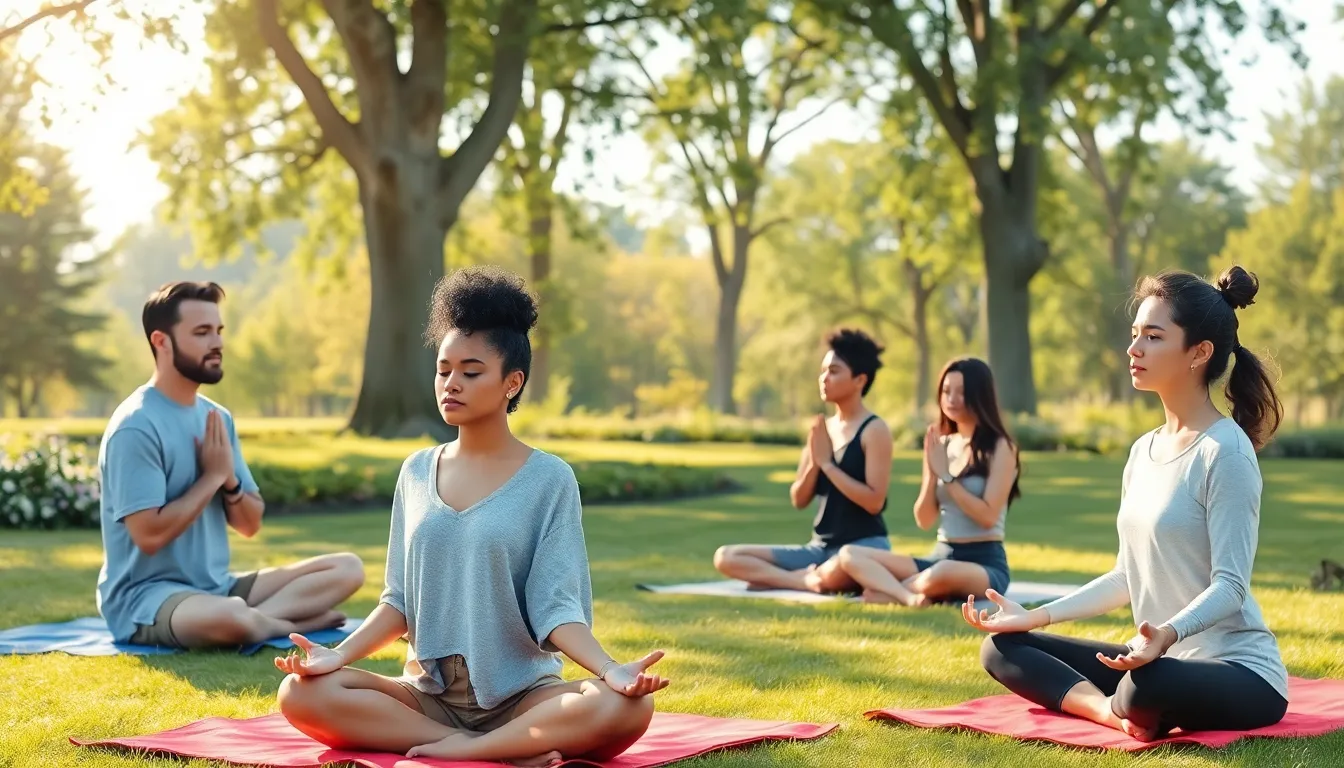Table of Contents
ToggleIn a world buzzing with distractions, finding peace can feel like searching for a unicorn in a haystack. Mindful living isn’t just a trendy buzzword; it’s a powerful approach that transforms chaos into calm. Imagine sipping your morning coffee while actually tasting it instead of scrolling through your phone—mind-blowing, right?
By embracing mindful living, one can unlock a treasure trove of benefits, from reduced stress to improved focus. It’s like giving your brain a spa day, without the awkward small talk with a stranger. This article dives into the art of being present, offering practical tips and a sprinkle of humor to make the journey enjoyable. So grab a seat, take a deep breath, and let’s explore how to live life with intention and a smile.
Understanding Mindful Living
Mindful living encompasses fully engaging with the present moment. This approach encourages individuals to cultivate awareness in daily activities.
Definition of Mindful Living
Mindful living refers to practicing awareness intentionally, focusing on thoughts, emotions, and sensations without judgment. This practice enhances individuals’ ability to respond thoughtfully to situations, rather than reacting impulsively. Emphasizing being present fosters a deeper connection to one’s experiences, ultimately promoting a sense of peace and clarity. Techniques such as meditation, breathing exercises, and mindful eating serve as valuable tools for embracing this lifestyle.
History and Background
Mindful living traces its roots back to ancient contemplative traditions. Buddhism prominently features mindfulness as a foundational practice, aiming to reduce suffering and promote enlightenment. In the 20th century, mindfulness gained recognition in the West through figures like Jon Kabat-Zinn, who introduced mindfulness-based stress reduction. This contemporary movement popularizes mindfulness in various contexts, such as healthcare, education, and personal development. As a result, mindful living has evolved into a versatile practice, benefiting individuals in multiple areas of life.
Benefits of Mindful Living


Mindful living offers numerous advantages that positively impact overall well-being. Practicing mindfulness enhances mental clarity and emotional stability.
Mental Health Improvements
Mindfulness reduces symptoms of anxiety and depression. Research from the American Psychological Association indicates that individuals who practice mindfulness experience lower stress levels. Practicing mindfulness helps people respond to triggers with awareness instead of automatic reactions. It fosters resilience through improved emotional regulation. Embracing mindfulness techniques strengthens self-awareness, allowing individuals to recognize their thoughts and feelings without judgment. Increased focus on the present moment leads to enhanced cognitive flexibility, enabling better problem-solving skills. Engaging with mindfulness practices cultivates a sense of gratitude, resulting in an overall boost in happiness.
Physical Health Benefits
Mindful living contributes to physical health in various ways. Clinical studies show that regular mindfulness practice improves immune function. It encourages healthier lifestyle choices, such as balanced eating and regular exercise. Mindfulness-based stress reduction techniques lower blood pressure and reduce chronic pain. Focusing on the present moment aids digestion, as it encourages mindful eating habits. Engaging in mindful practices enhances overall sleep quality, leading to restorative rest. Improved physical health often results from reduced levels of stress hormones, promoting long-term wellness. Embracing mindful living fosters a deeper connection between mental and physical health, creating a holistic approach to well-being.
Practices for Mindful Living
Mindful living encompasses various techniques that enhance awareness and focus in daily life. Below are practical methods for incorporating mindfulness into everyday routines.
Mindfulness Meditation Techniques
Mindfulness meditation promotes mental clarity and emotional stability. Practitioners often start with focused breathing, which entails concentrating on each inhale and exhale. Body scan meditations encourage awareness of physical sensations, helping individuals connect with how their body feels in the moment. Guided meditations provide direction through audio or apps, making the experience approachable for beginners. Engaging with nature can also serve as a form of meditation; observing surroundings deepens one’s connection to the present.
Incorporating Mindfulness in Daily Activities
In daily life, incorporating mindfulness becomes a transformative practice. Eating meals mindfully invites individuals to focus on flavors and textures, enhancing the dining experience. When walking, one can pay attention to each step, fostering a deeper awareness of the environment. Mindful listening encourages active engagement in conversations without distractions. Simple activities, like washing dishes or working, can transform into mindful practices through full attention. Regularly integrating these techniques promotes an intentional lifestyle that cultivates presence and awareness.
Challenges in Mindful Living
Challenges in mindful living can significantly hinder the practice. Identifying these obstacles is essential for cultivating awareness.
Common Obstacles
Distractions often surface in daily routines. Technology, with its constant notifications, disrupts focus. Stressful circumstances can trigger automatic responses, making presence difficult. Competing responsibilities can pull attention in multiple directions. Doubts about the effectiveness of mindfulness may also arise, creating hesitation to engage fully.
Strategies to Overcome Challenges
Prioritizing regular practice helps establish mindfulness as a habit. Creating a dedicated space for mindfulness activities fosters a conducive environment. Setting aside specific times for techniques like meditation ensures consistency. Engaging in short, intentional pauses throughout the day improves awareness during tasks. Sharing experiences with a community can provide motivation and accountability, enhancing commitment to the practice.




